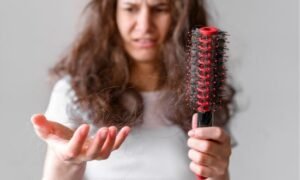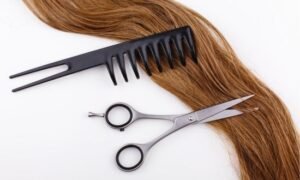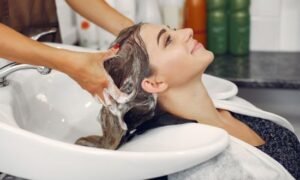In the world of beauty and self-care, the importance of a well-structured caring hair routine cannot be ignored. Just as with your skin, finding the right hair care regimen is essential for maintaining healthy and beautiful hair. However, with countless products and advice available, it can seem overwhelming to establish a hair care routine that suits your unique needs. This article will give you detailed insight on how to take care of your hairs as per your specific needs.
Importance of Caring hair
If you neglect hair care, your hair may eventually stop growing, and you could experience dandruff, hair fall, dryness, and dullness. Leaving your hair unwashed for extended periods can lead to ingrown hairs on the scalp and attract more dust. Using the wrong hair care products can result in itchiness and further contribute to hair fall.
Factors to Consider in Hair Care
Your journey to fantastic hair begins by understanding that no two individuals have the same hair type or concerns. The routine you develop should be personalized to cater to your specific needs. Some key factors to consider are:
A. Understanding the Basic Hair Types
When it comes to caring hair, the first step is understanding your hair type. Each person has different hair type. The basic hair types are straight, wavy, curly, and coily. Each of these types has its unique characteristics and care requirements.
- Straight Hair: Straight hair is generally smooth and lacks noticeable curls or waves. It tends to be naturally shiny but can become oily quickly. To maintain straight hair’s sleek appearance, you’ll want to focus on oil control and shine enhancement.
- Wavy Hair: Wavy hair comes in between straight and curly. It has gentle, loose waves that add volume and texture. Wavy hair requires products and routines that enhance these natural waves without weighing them down.
- Curly Hair: Curly hair is characterized by distinct curls or spirals. This type of hairs are prone to frizz and dryness. Proper hydration and frizz control are essential for maintaining healthy, defined curls.
- Coily Hair: Coily hair has tight, springy curls or coils. It tends to be dry and requires a lot of moisture to maintain its shape and health. Protective styles and deep conditioning are key for coily hair.
Factors Influencing Hair types
Understanding the diameter of your individual hair strands, as well as the density and porosity of your hair, will further refine your understanding of your hair type.
- Hair Strand Diameter: Hair strands can be fine, medium, or coarse. Fine hair is delicate and can be easily weighed down, while coarse hair is thicker and more robust. Medium hair falls somewhere in between.
- Hair Density: Hair density refers to how closely your hair strands are packed together. High density means many hair strands per square inch, while low density indicates fewer strands.
- Hair Porosity: Porosity relates to how well your hair absorbs and retains moisture. High porosity hair absorbs moisture quickly but can also lose it rapidly. Low porosity hair has difficulty absorbing moisture, making it prone to product buildup.
B. Specific Hair Concerns
Identify any specific issues you want to address, such as frizz, dryness, or a flaky scalp. Recognizing these problems is the first step in finding suitable solutions in caring hair.
C. Chemical Treatment of Hairs
If you’ve dyed, bleached, or subjected your hair to chemical treatments, it’s important to adapt caring hair routine. Dyed hair requires less frequent washing to prevent color fading and dryness, while bleached hair often needs additional nourishment in the form of conditioners and hair masks.
D. Preferred Hairstyles
The way you choose to style your hair daily matters. Heat styling tools can cause damage, so it’s essential to consider their use and its impact on your caring hair routine.
Essential Components of a Hair Care Routine
Irrespective of your hair type and specific concerns, there are fundamental steps that form the core of any effective hair care routine.
1. Cleansing
Cleansing your hair is a balancing act. It’s crucial to remove dead skin cells and product residue without stripping your hair of its natural oils. Regular cleansing prevents sebum buildup, which can make your hair appear greasy. Additionally, it rids your hair of accumulated dead skin and unwanted impurities. If you are a regular swimmer, it’s essential to remove chlorine from your hair as it can lead to damage over time.
Recommended Products:
- Clarifying Shampoo (use once a month to remove buildup)
- Daily Shampoo (for regular cleansing)
- Rinse-out Conditioner (apply to the middle and ends)
- Leave-in Conditioner (for added moisture)
- Deep Conditioner (ideal for dry-prone hair)
2. Conditioning
Conditioners provide numerous benefits, including moisturizing, detangling, reducing frizz, and enhancing shine. The main ingredient in conditioners, known as cationic surfactants, sticks to wet hair, coating strands to replenish moisture lost during shampooing. For added hydration, consider a two-step process: moisturizing and sealing, particularly beneficial for dry and coily hair types.
Recommended Products:
- Hair Lotion
- Oils (use sparingly)
3. Detangling
Detangling is a critical step in preventing hair breakage and making your hair care routine more manageable. However, it’s essential to use the right tools, such as a wide-tooth comb, to avoid inadvertently pulling out hair. Detangling frequency depends on your hair type.
wide-tooth comb, to avoid inadvertently pulling out hair. Detangling frequency depends on your hair type.
Recommended Tools:
- Wide-tooth Comb
- Detangling Brush
- Detangling Spray
- Detangling Serum
4. Styling and Protection
To style your hair as desired, you have an array of tools and products at your disposal. These include mousse, wax, pomade, gel, dry shampoo, volumizer, texturizer, shine serum, and hairspray. For those who use heated styling tools, a heat protection spray is vital to safeguard your hair from heat-related damage.
- Mousse, Wax & Gel
- Pomade
- Gel
- Dry Shampoo
- Volumizer & Texturizer
- Shine Serum
- Heat Protection Spray
5. Spot-Treatment
Recommended treatments for spot treatment in hair care can vary depending on the specific issue you’re trying to address. The choice of products and tools in this step can vary widely, so experimentation is encouraged.
Here are some common recommended treatments for spot treatment in caring hair:
Recommended Treatments:
- Scalp Treatments: If you’re dealing with scalp issues like dandruff or itchiness, using a medicated or specialized scalp treatment is recommended. Look for products containing ingredients like salicylic acid, coal tar, zinc pyrithione, or ketoconazole, which can effectively target these concerns.
- Protein Treatments: For areas of your hair that are
 damaged, weakened, or prone to breakage, protein treatments are beneficial. These treatments help strengthen the hair shaft, repair damage, and prevent further breakage. They often contain ingredients like keratin, amino acids, and hydrolyzed proteins.
damaged, weakened, or prone to breakage, protein treatments are beneficial. These treatments help strengthen the hair shaft, repair damage, and prevent further breakage. They often contain ingredients like keratin, amino acids, and hydrolyzed proteins. - Targeted Masks: Some hair masks are designed for spot treatment, focusing on specific issues such as dryness or lack of shine. They can be applied to the ends of your hair or other problem areas, providing intensive hydration, repair, or shine enhancement.
- Hair Growth Treatments: If you’re experiencing hair loss or thinning in certain areas, hair growth treatments are recommended. These treatments often contain minoxidil or other active ingredients that promote hair growth and can be applied directly to the affected areas.
- Anti-Frizz Serums: To control frizz and add shine to specific sections of your hair, anti-frizz serums are useful. Apply them to the ends of your hair or areas prone to frizz for a sleek and polished look.
- Moisturizing Masks: For dry, brittle, or damaged hair, moisturizing masks can be used as a spot treatment. These masks are rich in hydrating ingredients like oils, shea butter, and hyaluronic acid, and can restore moisture to dry or damaged areas.
- Aloe Vera Gel: Aloe Vera gel is a natural and versatile treatment that can be used for spot treatment on the scalp or hair. It’s excellent for soothing irritated or itchy scalps and can be applied directly to the affected area.
The Importance of Order and Consistency in Caring Hair
The order in which you apply products plays a significant role in the effectiveness of your hair care routine. While the sequence may vary based on your hair type and texture, here is a general guideline to follow:
- Shampoo or conditioner should be applied first.
- Follow with heat protection, a volumizer or mousse and shine serum.
- Finally, dry and style your hair, setting it with a gel or similar product, and finish with hairspray.
Note: Your final styling product should seal in moisture and promote hair health.
Resolving Common Hair Problems
Here is a list of common hair problems and their effective solutions:
| Hair Problems | Treatment or Solution |
| Dandruff | Address dandruff with specialized shampoos and treatments. |
| Hair Thinness | Can be managed by topical treatments, oral medications, and hair transplant surgery. |
| Split Ends | Prevent and manage split ends through regular trims and the use of hair serums. |
| Dryness | Combat dryness effectively with hydrating shampoos, conditioners, and regular deep conditioning. |
| Breakage | Protect your hair from breakage by avoiding tight hairstyles, excessive heat, and harsh chemical treatments. |
Dos and Don’ts in Caring Hair
Here is concise list of dos and don’ts in caring hair regime:
Hair Care Dos:
- Regularly wash your hair, adjusting the frequency based on your hair type.
- Prevent hair breakage with a wide-toothed comb, especially on wet hair.
- Gently dry your hair with a soft, old t-shirt or hair wrap.
- Use pre-shampoo treatments to nourish and protect your hair.
- Choose chemical-free shampoos for healthier hair.
- Apply conditioner to hair tips and rinse thoroughly.
- Trim your hair every 6-8 weeks to prevent split ends.
- Opt for natural drying methods to minimize heat damage.
- Stay hydrated by drinking at least 3 liters of water daily. To keep track of your daily water intake and your body’s hydration status, check out our user friendly water intake calculator.
- Maintain a balanced diet rich in proteins and essential nutrients.
 Hair Care Don’ts:
Hair Care Don’ts:
- Avoid hot showers to prevent loss of natural scalp oils.
- Avoid hair wash with salt water as it can damage the hair cuticle.
- Reduce the use of heat styling tools to prevent dryness and breakage.
- Manage stress to reduce the risk of hair fall.
- Limit chemical treatments like dyeing and perming.
Frequently Asked Questions
- How often should I wash my hair?
There’s no one-size-fits-all answer to this question. The frequency of hair washing depends on your hair type, lifestyle, and the products you use. Some people may wash their hair three times a week, while others do so less frequently.
- How do I determine the ideal frequency of using products for caring hair?
The ideal frequency depends on your hair’s specific needs. Pay attention to how your hair feels and looks. If it becomes greasy quickly, you may need more frequent washing. If it tends to be dry, less frequent washing may be suitable.
- Is it true that hair changes its texture every seven years?
While the saying has some truth, it’s not an exact science. Hair texture can change over time due to various factors like hormonal changes, aging, and environmental influences.
- What are common signs that my hair’s needs are changing?
Signs of changing hair needs can include increased dryness, more oiliness, changes in curl pattern, and a difference in how your hair responds to products.
- What products are suitable for winter hair care?
In winter, thicker creams and moisturizing products are favorable to combat dryness and static caused by indoor heating and cold weather.
- How can I protect my hair from seasonal damage, such as sun exposure?
To protect your hair from sun damage, especially during summer, consider wearing hats and using products with UV protection. These can help prevent dryness and color fading.
For any further query about this condition feel free to contact us at https://medicalinquiries.com/contact-us/
Conclusion
In conclusion, having beautiful and healthy hair is achievable. To make it happen, know your hair type, create a personalized care plan, and follow the right steps. If you face hair loss or damage despite good care, seek help from a healthcare professional or a skin doctor. Your hair health matters for your well-being, so appreciate yourself no matter what your hairs condition is. Taking care of your hairs will boost your confidence and style.
Disclaimer
Content on this site is written with thorough research and keeping in mind the latest guidelines. However, no content on this site should substitute professional consultation.

